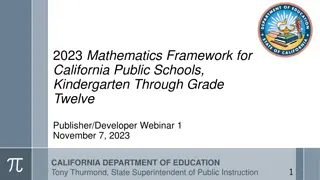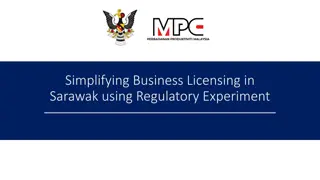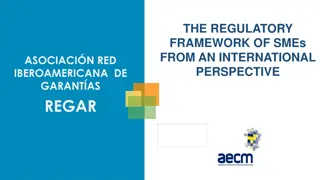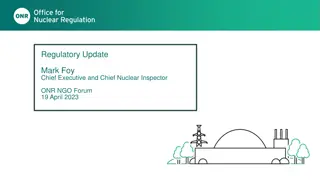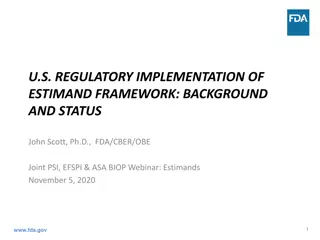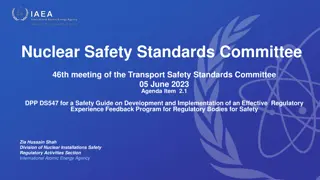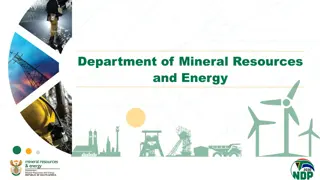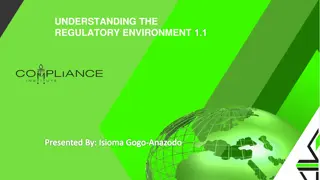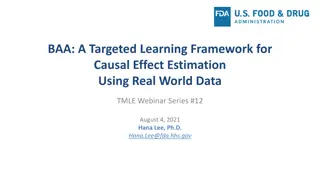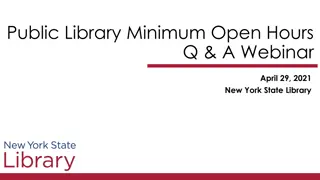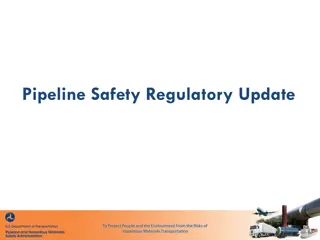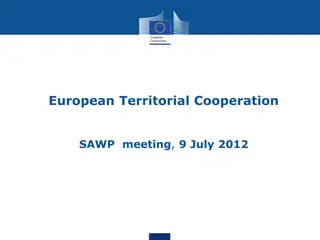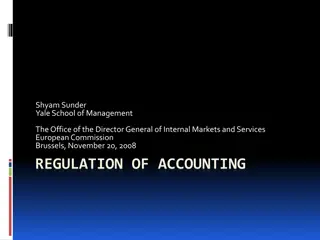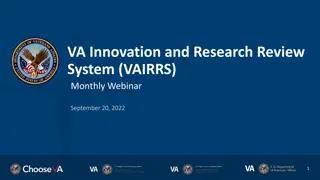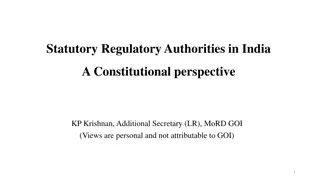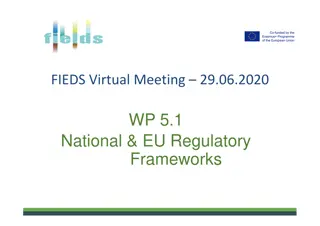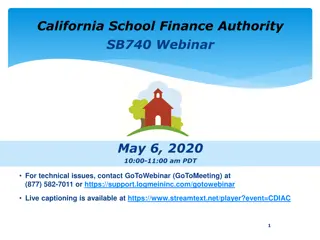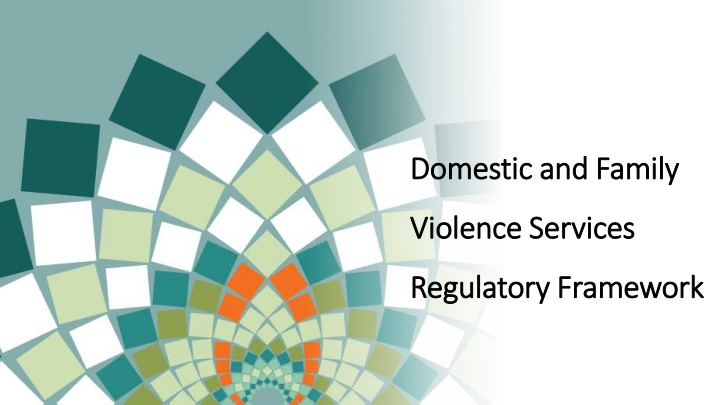
Domestic and Family Violence Practice Standards in Queensland
Explore the regulatory framework and Practice Standards in place for working with domestic and family violence perpetrators in Queensland. Learn about the importance of compliance, quality assurance, and the everyday practice expectations for workers in the DFV system.
Download Presentation

Please find below an Image/Link to download the presentation.
The content on the website is provided AS IS for your information and personal use only. It may not be sold, licensed, or shared on other websites without obtaining consent from the author. If you encounter any issues during the download, it is possible that the publisher has removed the file from their server.
You are allowed to download the files provided on this website for personal or commercial use, subject to the condition that they are used lawfully. All files are the property of their respective owners.
The content on the website is provided AS IS for your information and personal use only. It may not be sold, licensed, or shared on other websites without obtaining consent from the author.
E N D
Presentation Transcript
Domestic and Family Domestic and Family Violence Services Violence Services Regulatory Framework Regulatory Framework
Rec 82 of Not Now, Not Ever: Putting an end to domestic and family violence in Queensland: c) [That the Queensland Government] establishes a clear and rigorous process for evaluating and approving initiatives and providing ongoing monitoring of compliance with the Practice Standards [for working with men who perpetrate domestic and family violence] to ensure that issues of non- compliance and service system development requirements are identified. Why a regulatory framework? Why a regulatory framework? 2ndAction Plan under the DFVP Strategy: Action to develop a quality assurance framework and audit process to ensure ongoing compliance with the Professional Practice Standards for working with perpetrators of domestic and family violence.
Practice Standards Practice Standards Revised Practice Standards came into effect on 1 January 2021: https://www.justice.qld.gov.au/about-us/services/women-violence- prevention/violence-prevention/service-providers/practice-principles- standards-guidance Bring together all DFV service types under one consolidated set of standards (previously separate standards for women s services and men s services) Updated to reflect: improved practices and procedures that have been developed by specialist DFV services contemporary theoretical frameworks national and state policies and strategies legislative amendments
What are practice standards? What are practice standards? Outline the everyday practice expectations of workers in the DFV system Reflects the quality of services the community can expect from organisations that provide Queensland Government funded DFV services Complement profession specific practice standards already in place for groups such as social workers, psychologists etc. (where applicable)
Structure of the Structure of the Practice Standards Practice Standards Outline what all clients victims and perpetrators should be able to expect from DFV services in Queensland Principles Outline a consistent approach to responding to DFV for all service sectors Elements that must be in place in order to give effect to the principles Standards Translates the standards into practice Highlights activities and examples of practice that allow staff to meet each standard and bring the standards to life in their daily practice Practice guidance
Practice Standards Reflection Practice Standards Reflection How would you rate your understanding and awareness of the practice standards? How do the Practice Standards influence your practice, leadership and governance? Is there anything that you have found helpful or beneficial in implementing the revised Practice Standards?
Framework Framework Approach Approach Practice standards at the core (victim safety, perpetrator accountability and culturally safe and inclusive practice). The implementation and monitoring of these standards are supported through current frameworks in place via funding agreements. Embodied by services through their governance, core values and structure. Key concepts are then incorporated and delivered through partnering with the community to deliver high quality services that are connected, safe and inclusive.
Service Delivery Context of the Regulatory Framework Service Delivery Context of the Regulatory Framework Legal and contractual requirements Monitoring and compliance Human Services Quality Framework Services must be certified as per the Human Services Quality Standards common requirements Community Services Act 2007 DFV service providers Investment Specifications Set out requirements for service types and users Domestic and family violence support services Sexual violence services Domestic and Family Violence Regulatory Framework Compliance with DFV Practice Standards Individual service agreements Require services to be HSQF-compliant Women s health and wellbeing services Other services Domestic and Family Violence Protection Act 2012 WorkUP Queensland Workforce capacity and capability building
Key Information Key Information All department funded DFV services that includes: DFV support services, perpetrator intervention services, women s shelters and integrated service responses funded through system support. WHO Promote greater consistency, transparency and integration of services around client needs reflects the quality of services the community WHY The Regulatory Framework is operationalised through the Human Services Quality Framework (HSQF), through DFV-specific criteria embedded into the HSQF user guide. HOW The Regulatory Framework is a monitoring and compliance mechanism to ensure a high standard of service delivery across DFV services that demonstrates compliance with the Practice Standards. WHAT The Regulatory requires compliance from 1 January 2022 WHEN
Development and Consultation Development and Consultation Guiding Principles of Development Consultation Summary As much as possible, to minimise the administrative burden and potential increase in costs to the DFV sector. There was a significant period of consultation from July 2020 to May 2021 to ensure that The Regulatory Framework is fit for purpose. The development phase included extensive consultation with the wider DFV sector, targeted more at a management and organisational level. That the Regulatory Framework is designed and developed in response to sector feedback and expert advice. Some key groups within consolation included: o Technical experts in auditing human services organisations; o Certification bodies; o DFV peak bodies; o Key stakeholders within the DFV sector; o Service representatives who formed working groups for the project That the Regulatory Framework is fit for purpose and appropriately operationalised to fit the sectors need. Ensure that auditors have the specific skills and training to meaningfully and appropriately assess DFV practice.
Who does the Regulatory Who does the Regulatory Framework apply to? Framework apply to? WHO All funded DFV services will be required to comply: specialist DFV services including court support, women s shelters and counselling (adult and children) perpetrator intervention programs integrated service responses funded by the Department WHY Research and events are not within scope of the Regulatory Framework HOW Non DFV specialist services may wish to voluntarily comply the Regulatory Framework with benefits including: provide service that is inclusive and culturally appropriate, better understand power, control and the gendered nature of violence, be integrated and collaborative, have the skills and capabilities to work effectively with a broad range of clients, to promote greater consistency, transparency and integration of services around client needs. WHAT WHEN
The Purpose of the The Purpose of the Regulatory Framework Regulatory Framework WHO WHY Providing an effective system for monitoring compliance with the Practice Standards, while minimising administrative burden on the sector where possible. Promoting practice consistency, and accountability, transparency and integration of services based on client needs. HOW Encouraging continuous improvement in service delivery, particularly regarding victim safety, perpetrator accountability and service integration across the sector. WHAT Ensuring accessibility of DFV services for the full range of clients, in recognition of the diversity WHEN of the Queensland community.
The Regulatory Framework is operationalised through the Human Services Quality Framework (HSQF), the Queensland Government s existing monitoring and compliance framework in place for all funded human services organisations, including DFV specialist services WHO Human Services Quality Framework Human Services Quality Framework and Regulatory Framework and Regulatory Framework WHY DFV services seeking certification or re-certification under the HSQF must demonstrate all common requirements for all indicators as outlined in the HSQF user guide, as well as the DFV specific requirements. In the HSQF user guide, these requirements are identifiable by the following icons: HOW Specialist DFV criteria and suggested evidence has been developed and embedded into the HSQF user guide. The user guide sets out what services must demonstrate, and what evidence they could provide, to support an auditor to assess their DFV service delivery. WHAT WHEN
Regulatory Framework Structure Regulatory Framework Structure WHO HSQF Supplement and HSQF User Guide Regulatory Framework document WHY Compliance requirements and guidance Introduction and context Compliance framework Introduction and background Why do we need a regulatory framework? What has already been done? What services are captured under the framework? HOW Assessment criteria Reflecting the new practice standards What are the requirements services must comply with? DFV Practice Standards Evidence requirements Possible documentation, observation and interview evidencefor each standard Background Queensland s reform agenda Practice standards development How will compliance, non- compliance and complaints be assessed and measured? Oversight Alignment with HSQF Audit processes Quality assurance for auditors WHAT Context / landscape Queensland s funded services Legislation Practice standards Investment specifications Service agreements WHEN
Overview of Regulatory Overview of Regulatory Framework Criteria and Framework Criteria and Evidence Evidence WHO 49 Practice Standards 29 HSQF Indicators WHY Regulatory Framework Criteria in 11 HSQF Indicators Criteria The criteria and suggested evidence are not intended to be restrictive or prescriptive, rather, they seek to identify the what of good practice, rather than how services should be delivered HOW Suggested evidence (no criteria) provided in 2 HSQF Indicators The criteria identify the elements within the Practice Standards that are associated with best practice Evidence The suggested evidence within the Regulatory Framework has been developed to assist DFV practitioners, services and auditors to identify what best practice may look like in DFV service delivery The evidence is not a check list of what services should be delivering or have in place, but a series of examples of what may help demonstrate that services are meeting the criteria WHAT WHEN
Criteria and suggested evidence Criteria and suggested evidence WHO XXX WHY HOW WHAT WHEN
Timeline and Important Dates Timeline and Important Dates WHO WHY 1 Jan 2022 1 July 2021 1 Jan 2021 July 2020 Regulatory Framework comes into effect Regulatory Framework published Practice Standards came into effect Practice Standards released HOW CONSULTATION & DEVELOPMENT ON-BOARDING COMPLIANCE WHAT The Regulatory Framework criteria and suggested evidence will be published in the HSQF user guide on 1 October 2021 Services will be required to comply by 1 January 2022 through the HSQF audit process. WHEN Delayed compliance for Aboriginal and Torres Strait Islander Services by 12 months and a grace period for shelters has also been endorsed.
Compliance Exemptions Compliance Exemptions Delayed compliance Aboriginal and Torres Strait Islander Services (T310 funding stream) Major non-conformity exemption Women s Shelters There is an optional delayed compliance period of 12 months Aboriginal and Torres Strait Islander servicesto demonstrate their compliance under the Regulatory Framework (through their HSQF audits) Shelters have been brought into the HSQF more recently and may not have the same level of experience preparing for audit as other services This is in recognition that Aboriginal and Torres Strait Islander services: Shelters will be exempt from major non- conformances during their first audit, if it falls within six months after 1 January 2022 (recertification or maintenance audit). o were not previously required to comply with the Practice Standards may have different models of service provision, and to support these services to maintain their culturally specific work Services would not be required to be audited against the new DFV specific requirements as part of their HSQF certification process until their first scheduled audit after 1 January 2023, although they may still elect to as a preparatory exercise. o o Shelters will therefore have additional time to address any major issues identified through the audit, consistent with the process for addressing standard non-conformances.
Scheme Rule Changes Scheme Rule Changes Auditor Training/DFV Technical Expert Sampling of Service Outlets Scheme Rule: For human service organisations that deliver domestic and family violence services across multiple sites and/or outlets (including perpetrator intervention services and women s shelters), the certifying body shall ensure that 100% of sites/outlets are sampled at least once during the three-year certification cycle. Scheme Rule: All audit team members must be able to demonstrate a minimum level of DFV competence by: having completed DFV practice training developed for auditors as specified by the HSQF team or engaging a DFV technical expert to support the audit team Rationale / benefits: No/low additional workload for auditors as overall number of outlets sampled at each audit won t significantly change Ensures every outlet is sampled once every three years. Auditors can t sample the same outlets every time Rationale / benefits: Certification Bodies were very supportive of DFV training for auditors Auditors will have the option of also engaging a technical expert,
Supporting the sector to implement the Regulatory Framework Supporting the sector to implement the Regulatory Framework Audit Support Funding Auditor Training Resources All services funded by the DJAG to provide DFV services will be provided with additional one-off discretionary funding to support compliance with the Practice Standards through the Regulatory Framework. Factsheet information and operationalisation of the Regulatory Framework. summarises the key Any auditor auditing a DFV service under the Regulatory Framework will be required to complete departmentally provided DFV training. Services self-assessment document has been developed to support services in doing a self-assessment against the Regulatory Framework criteria and evidence, relevant practice standards across the HSQF indicators. This training is to ensure auditors have the necessary knowledge, nuanced understanding, and skill to appropriately audit DFV practice using the Regulatory Framework criteria This funding is intended to be used to support compliance through either: assisting with the audit costs associated with the services first audit under the Regulatory Framework, or used to support services in becoming compliant (for example, amending policies, procedures and processes to ensure alignment with compliance requirements). The first training will be delivered in November 2021, with ongoing delivery on a needs basis. Online webinar will be uploaded to the webpage, following live state-wide delivery. The webinar is intended to outline the purpose, operationalisation and preparation required for services to be compliant with the Regulatory Framework by 1 January 2021.
WorkUp Queensland WorkUp Queensland Capability and capacity building body for the domestic and family violence, sexual violence and women's wellbeing services Partnership between ANROWS and the Aboriginal and Torres Strait Islander Healing Foundation WorkUp Queensland also offers: practice studios, knowledge circles, professional development and workforce planning for the DFV sector can assist services in preparing for the implementation of the Regulatory Framework.
Next Steps for Services Next Steps for Services Read and understand both the Framework document and HSQF supplement that includes the DFV criteria and suggested evidence Review our resources on our dedicated service provider webpage Communicate with staff regarding the implementation of the Regulatory Framework and any changes required to practice Provide and encourage staff to undertake professional development if needed Review organisational policies and procedures and update as needed Implement continuous monitoring and improvement processes.
Practice Principles and the Regulatory Framework Practice Principles and the Regulatory Framework The Practice Standards are informed by a range of theoretical frameworks that underpin good practice in responding to the needs of both victims and perpetrators of violence. These practice principles are embedded within the Regulatory Framework and are core elements of DFV practice. Perpetrator Accountability Inclusion and Accessibility Victim Safety Integration Principle 5 Services are culturally safe for Aboriginal and Torres Strait Islander people Principle 3 Services are evidence-informed Principle 1 The rights, safety and dignity of victims are paramount Principle 4 Perpetrators are held accountable for their actions Principle 7 Services collaborate to provide an integrated response Principle 2 Staff understand domestic and family violence Principle 6 Services are client-centred and accessible for all
Perpetrator Accountability Inclusion and Accessibility Victim Safety Integration A gendered lens acknowledges the power imbalance that underpins domestic and family violence and how perpetrators exercise power and control over victims Principle 2 Principle 2 - - Staff understand Staff understand Domestic and Family Violence Domestic and Family Violence Intersectionality is important and ensures that victims experience and understand violence in different ways based on intersecting experiences with other forms of disadvantage, for instance related to race, class, level of ability and sexuality. Victim Safety Applying a gender lens is vital for developing equitable policies, programs and services, and achieving gender equality.
Inclusion and Accessibility Victim Safety Perpetrator Accountability Integration Perpetrator Accountability ensuring legal and police responses are adequate and include penalties for breach of orders a focus on encouraging the perpetrator to understand and take responsibility for their actions a focus on avoiding collusion with perpetrator or unintentionally reinforcing violence supportive attitudes and behaviours. Principle 4 Principle 4 Ensuring safety, responsibility and Ensuring safety, responsibility and accountability accountability System Accountability delivering high quality services through compliance processes, providing responses that support perpetrator accountability and victim safety through integrated services responses and with a view to continuous improvement.
Victim Safety Perpetrator Accountability Inclusion and Accessibility Integration Cultural Safety Definition Is determined by Aboriginal and Torres Strait Islander Peoples. Principle 5 Principle 5 Ensuring Cultural Safety Ensuring Cultural Safety Respect and recognition of cultural differences, by acknowledging that Aboriginal and Torres Strait Islander Peoples are the First Nations Peoples. Creating environments where peoples feel safe and there s no challenge to their identity and their needs can be met. This has ties to the physical environment, language, social structures, symbolic actions, sharing power, and developing knowledge, understanding and learning. Is the responsibility of all individuals, services and organisations through an understanding and acknowledgement of past injustices and Partnerships Participation Protection Reform
Perpetrator Accountability Inclusion and Accessibility Victim Safety Integration Integrated Service Response: Integration is widely regarded as best practice in service responses to domestic and family violence. Principle 7 Principle 7 Services collaborate to provide an Services collaborate to provide an integrated response integrated response Integrated service responses are focused on the social and political structures that reinforce the safety of women and children and hold perpetrators to account for their behaviour. Formal/funded: may include High Risk Teams (HRT), hubs or other funded and established integration responses as a component of coordinated the integrated responses from services. Informal/unfunded: localised networks that relationships between agencies, organisations and communities that support integration and appropriate information sharing.
Integration in Practice Integration in Practice May vary dependant on the level of formal integration. Processes for risk assessment and safety planning May include localised policies, state or national frameworks and legislation, High Risk Teams and integration Hubs that coordinate responses Common Risk and Safety Framework Process & Practice Authorising environment Formal and informal system accountability mechanisms Information Sharing Guidelines (2016) Information Sharing Integration Services share information across all levels of practice from staff, managers and through the governance structure Established mechanisms that delineate referral processes and pathways, access to shared case-management etc
Embedding Principles into Practice Embedding Principles into Practice It is important that these core principles are measurable in some form, and that any measure should seek to also address governance, senior management and practitioner practice requirements LEVEL EXAMPLE Governance Understanding and engaging in reflection Individual practice Holding perpetrators to account in each contact Ensuring that culturally safe practice, beliefs and understanding is embedded in all levels of an organisation from governance through to policy and demonstrated in practice is crucial. Workplaces Officer level integration Reflective supervision Workplaces Ensuring appropriate training and personal development Individual practice Local and regional accountability (between services) System level accountability (compliance, audits) Governance Robust policies and procedures PRACTICE STANDARDS System level integration
Regulatory Framework Reflection Regulatory Framework Reflection How do you perceive the Regulatory Framework will influence your practice, leadership and governance? What is something you think you can implement to align practice with the Regulatory Framework? What other information, resources and training do you feel would support improved understanding and compliance with the Regulatory Framework?
For more information For more information Visit our dedicated service provider webpage: https://www.justice.qld.gov.au/about-us/services/women-violence- prevention/violence-prevention Contact: your regional Contract Officers Email: The DFV Service System Reform Team at DFVServiceSystemReform@justice.qld.gov.au

